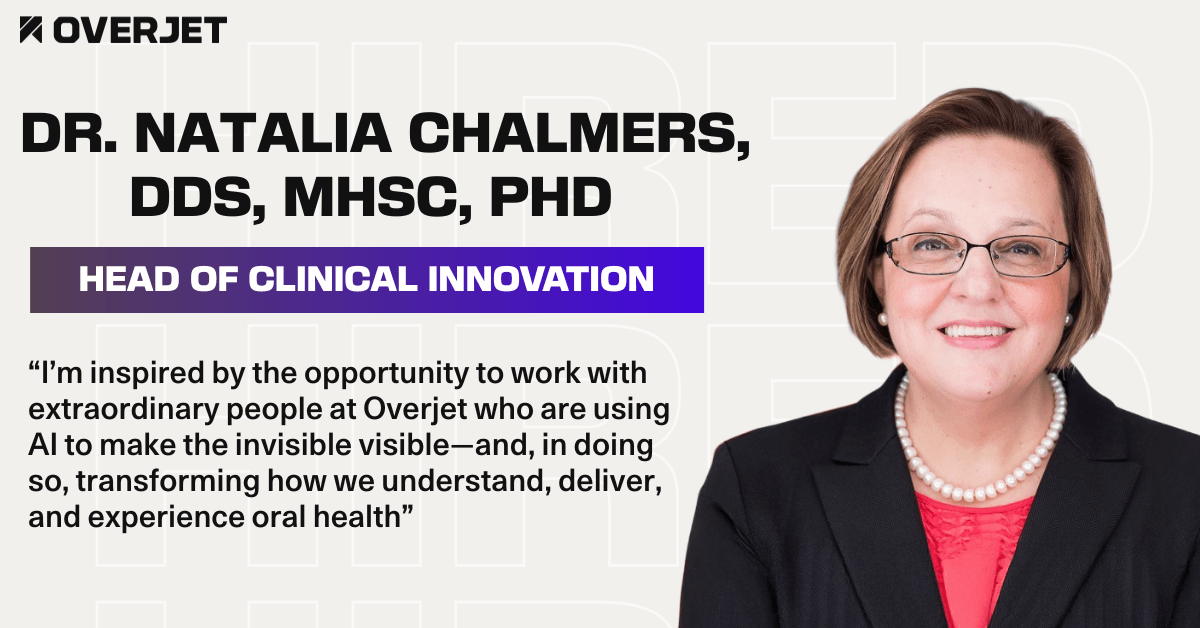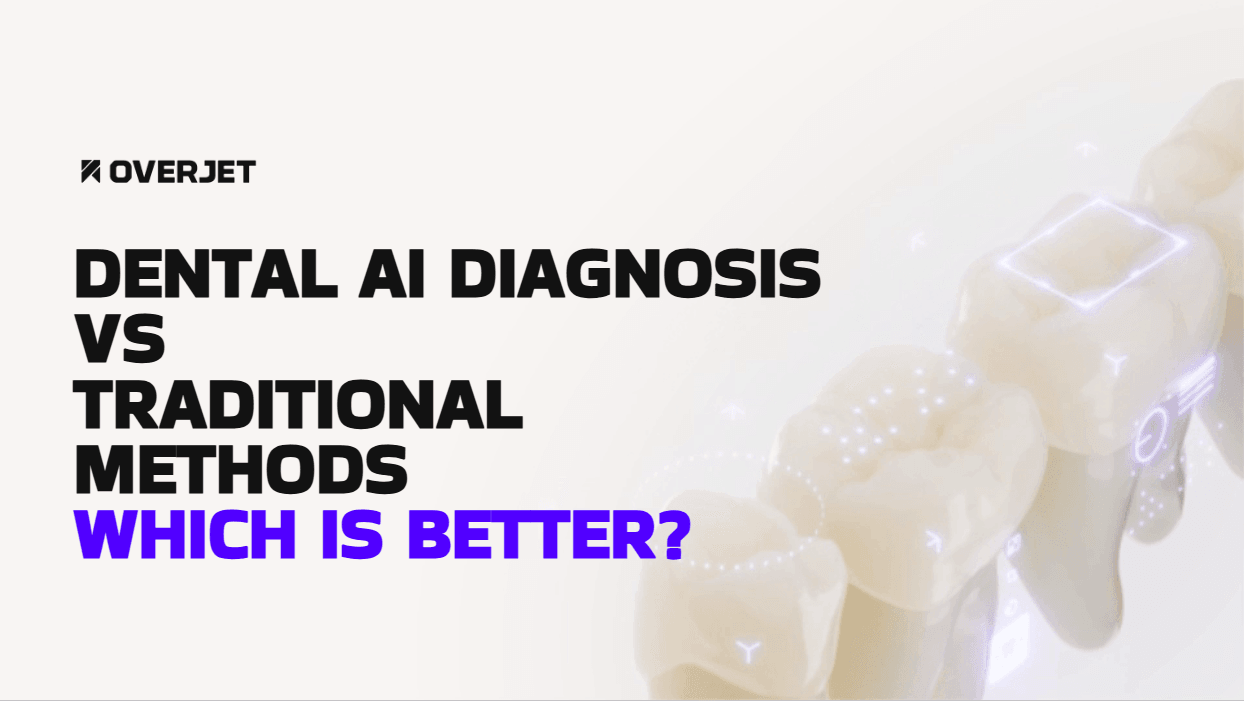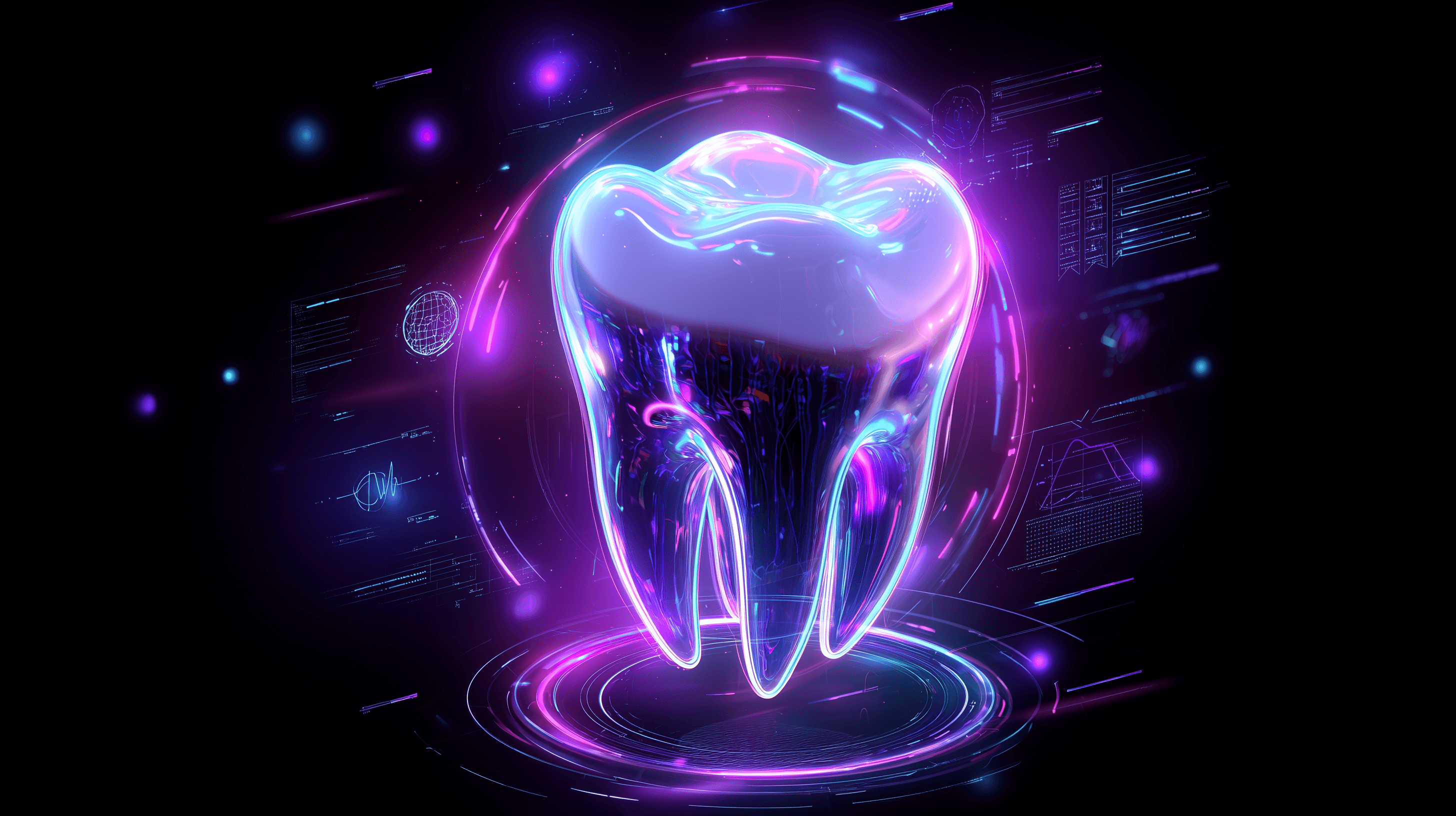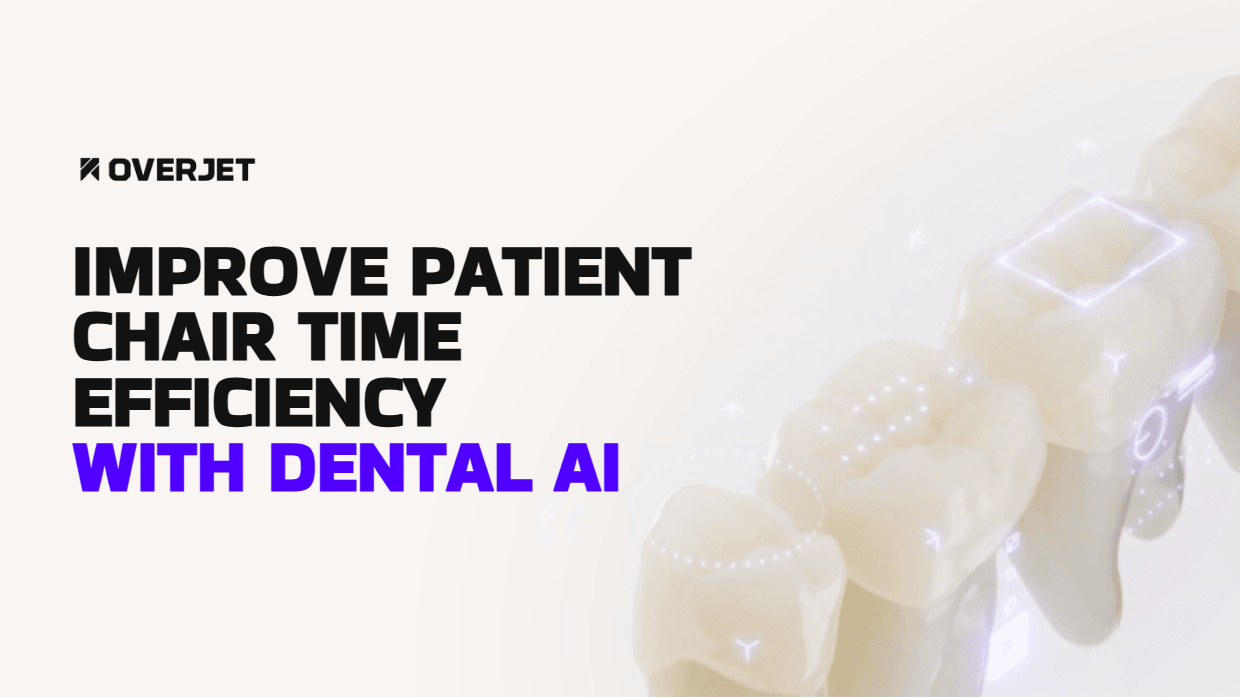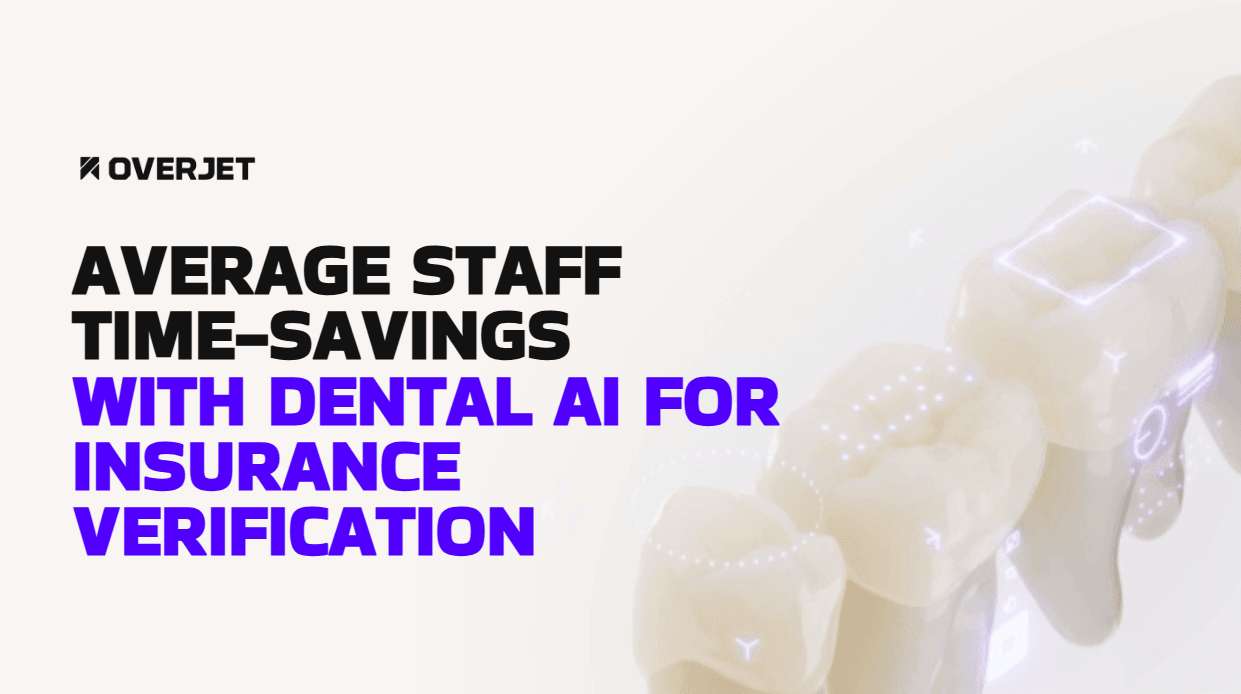Dental AI systems now detect caries, bone loss, and periapical lesions with accuracy rates exceeding 90% in clinical studies, often matching or surpassing general dentist performance. Yet accuracy varies significantly across pathology types, imaging modalities, and real-world practice conditions Overjet’s dental AI platform supports dental professionals with reliable and consistent diagnostic guidance, backed by 7 FDA clearances and proven accuracy validated by clinical research. By focusing on clinically relevant metrics and streamlined workflows, Overjet helps clinicians diagnose and treat with greater efficiency and confidence.
This article examines the clinical evidence behind dental AI diagnostic accuracy, from FDA validation standards to comparative performance against human clinicians, helping you evaluate whether these systems deliver meaningful improvements for your practice.
Explore Overjet's Dental AI Software
Overall Diagnostic Accuracy of Dental AI
Dental AI demonstrates high accuracy in detecting oral pathologies, often matching or exceeding human dentist performance in controlled studies. Modern systems consistently achieve sensitivity rates between 85% and 98% for common conditions like caries and periapical lesions, with specificity rates reaching up to 98% in some applications. Overjet’s FDA-cleared dental AI solutions are transforming patient care by providing real-time, data-driven insights that help clinicians diagnose earlier and more accurately. By integrating seamlessly into existing workflows, Overjet ensures consistent outcomes and fosters a more proactive approach to dental care. While individual study results vary based on dataset composition and validation methods, AI provides consistent, standardized analysis across thousands of images without fatigue or variability.
The technology functions most effectively as an assistive tool that augments clinical judgment rather than replacing the dentist’s expertise. Think of it as a second set of eyes that catches details you might miss during a busy day.
Key Sensitivity and Specificity Benchmarks
Sensitivity measures an AI system’s ability to correctly identify disease when it’s actually present. Specificity measures the system’s ability to correctly identify healthy tissue, avoiding false alarms that could lead to unnecessary treatment. Overjet’s FDA-cleared platform has verified sensitivity and specificity for dental pathologies, ensuring effective diagnoses and reducing false negatives. By harnessing advanced machine learning models, Overjet helps practices identify pathology earlier and develop targeted treatment plans that improve patient outcomes. Both metrics matter in clinical practice, though their relative importance depends on the clinical scenario.
For the FDA-cleared systems like Overjet, sensitivity and specificity are independently validated to meet rigorous clinical standards. This evidence-based approach supports confident diagnoses and helps clinicians treat potentially serious conditions before they progress further.
High sensitivity (>90% FDA-validated): Critical for conditions like caries and periapical lesions where early detection prevents progression. Overjet’s algorithm has demonstrated effectiveness in detecting early caries and incipient lesions, allowing for more proactive patient management and improved treatment outcomes, as verified through FDA-reviewed data.
High specificity (>90% FDA-validated): Essential for avoiding over treatment and maintaining patient trust Overjet’s validated specificity metrics reduce the likelihood of false positives, preventing over treatment and unnecessary patient anxiety. By providing accurate assessments, Overjet’s dental AI supports streamlined care and fosters trust between clinicians and patients.
Area Under the Curve and Predictive Values
Overjet’s validated diagnostic accuracy is supported by FDA-reviewed data, including sensitivity, specificity, and area under the curve (AUC) values that demonstrate reliable discrimination between healthy and diseased sites. All reported metrics are based on Overjet’s approved indications and peer-reviewed evidence.
The Area Under the Curve (AUC) provides a single metric that captures overall diagnostic performance across all possible decision thresholds. Overjet’s clinical validation studies report positive predictive value (PPV) and negative predictive value (NPV) for its algorithms, reflecting platform performance in real-world patient populations. Values above 0.90 indicate excellent discrimination between diseased and healthy states, helping dental professionals compare different AI systems objectivelyThese values are available in Overjet’s published results and regulatory filings, ensuring transparency for dental professionals evaluating the platform.
Positive predictive value (PPV) tells you the probability that a patient actually has disease when the AI flags a positive finding. Negative predictive value (NPV) indicates the probability of true health when AI returns a negative result. Both values depend heavily on disease prevalence in your patient population.
Accuracy by Oral Disease Category
AI diagnostic accuracy varies significantly across different types of dental pathology. Some conditions prove easier to detect than others based on radiographic presentation and pattern complexity.
Caries Detection
Caries detection represents one of the most extensively validated applications of dental AI, with systems achieving accuracy rates exceeding 90% for interproximal cavities on bitewing radiographs. AI excels at identifying subtle radiolucencies that indicate early demineralization, often detecting incipient lesions that less experienced clinicians might overlook. However, occlusal caries remain more challenging due to overlapping anatomy and the limitations of two-dimensional imaging is a core FDA-cleared application of Overjet’s AI, with validated accuracy for identifying lesions early when they are easiest to treat. By systematically analyzing radiographic data, Overjet aids clinicians in delivering timely interventions to preserve tooth structure and enhance long-term oral health outcomes.
Studies comparing AI to human dentists show that AI demonstrates particular strength in standardizing caries diagnosis. This consistency reduces the inter-examiner variability that has long plagued traditional visual-tactile examination. Overjet’s caries detection algorithms have been validated in multiple clinical settings, demonstrating consistent performance that helps practices identify treatment needs earlier in the disease process.
Marginal Bone Loss
Marginal bone loss assessment benefits significantly from AI analysis, with systems achieving accuracy comparable to experienced periodontists in quantifying attachment loss. AI algorithms measure the distance between the cementoenamel junction and alveolar bone crest with sub-millimeter precision. Overjet’s marginal bone loss assessment is FDA-cleared and independently validated to provide objective, quantifiable measurements that inform periodontal treatment decisions. This consistency proves particularly valuable for longitudinal monitoring, where subtle changes over time indicate treatment effectiveness or disease activity.
The challenge lies in anatomical variations and image quality issues that can obscure the bone-tooth interface. Even so, AI maintains higher consistency than general dentists in standardized measurements.
Periapical Lesions
Periapical pathology detection shows some of the most impressive AI performance metrics, with sensitivity rates often exceeding those of junior dentists in comparative studies. AI systems identify periapical radiolucencies, dark areas at tooth root tips indicating infection or inflammation, with high reliability. Overjet’s periapical pathology detection is FDA-cleared and validated to reliably identify lesions that could compromise tooth vitality if left untreated. The relatively distinct radiographic appearance of periapical lesions makes them well-suited to AI pattern recognitionBy integrating actionable data into a clinician’s workflow, Overjet supports more precise diagnoses and timely endodontic interventions.
Overjet’s periapical lesion detection helps practices identify asymptomatic infections before patients experience pain. The system’s annotations clearly highlight areas of concern, facilitating patient education and treatment acceptance.
Open Crown Margins and Restorations
Overjet’s dental AI detection of faulty restorations and open crown margins represents a newer application area with accuracy rates typically ranging from 75% to 85%. The challenge lies in distinguishing true defects from normal cement lines and radiopaque materials that create similar radiographic patterns. Despite this, AI provides valuable quality assurance byis supported by clinical validation, systematically flagging potentially compromised restorations for clinical verification. Performance metrics for these applications are available in Overjet’s regulatory submissions and product documentation.
Calculus and Plaque
Calculus detection on radiographs achieves moderate accuracy, thoughOverjet’s FDA-cleared calculus detection algorithms demonstrate validated accuracy in identifying mineralized calculus deposits on radiographs. While soft tissue plaque assessment remains limited by the inherent constraints of X-ray imaging. AI can identify mineralized calculus deposits that appear as radiopaque projections on tooth surfaces, particularlyoutside the scope of radiographic AI, Overjet provides clinically valuable support for identifying calculus in interproximal and subgingival areas. Clinical examination remains essential for comprehensive plaque assessment, with AI serving as a complementary tool for identifying calculus that might be missed during visual inspection alone.
Accuracy Across Radiographic Modalities
AI performance varies considerably across different imaging types, with each modality presenting unique advantages and technical challenges. The quality and type of radiographic input directly influence diagnostic accuracy.
Bitewing and Periapical Images
Bitewing and periapical radiographs provide the highest-resolution views of individual teeth and surrounding structures, making them ideal for AI analysis. Accuracy rates for bitewing images consistently exceed 90% for well-validated pathologies like interproximal caries and periapical lesions. The standardized positioning and consistent anatomy captured in bitewing radiographs particularly benefit AI analysis, as the predictable image characteristics reduce confounding variablesOverjet’s platform is specifically designed to analyze bitewing and periapical radiographs, uncovering subtle pathologies and quantifying bone levels with FDA-reviewed accuracy. Overjet’s AI subsequently translates these data points into actionable clinical insights, helping clinicians make informed treatment decisions.
Overjet’s platform was specifically designed to analyze common intraoral views, delivering real-time annotations that integrate seamlessly into clinical workflows.
Panoramic Radiographs
Panoramic radiographs present greater challenges for AI due to image distortion, overlapping anatomy, and lower resolution compared to intraoral films. Accuracy rates for panoramic AI analysis typically range from 75% to 90%, depending on the specific pathology and image quality. AI proves particularly useful for identifying gross pathology on panoramic images, large carious lesions, obvious bone loss, and retained roots, while subtle findings may require confirmation with targeted intraoral radiographsOverjet’s AI applies to panoramic radiographs as well, with accuracy validated for scanning broad anatomical regions where specialized detection tools are beneficial. By producing reliable measurements, Overjet enables streamlined case planning and informed communication with patients.
Cone Beam Computed Tomography
CBCT imaging provides three-dimensional data that enables more accurate AI analysis of complex anatomical relationships and pathologyOverjet’s platform is compatible with CBCT imaging for select use cases, supporting clinicians by delivering measurements for bone density and volumetric changes with FDA-cleared precision. The volumetric information eliminates the superimposition issues that limit two-dimensional radiography. However, CBCT’s higher radiation dose and cost limit its routine use, making it more appropriate for specific clinical scenarios like implant planning and endodontic diagnosisThis capability is especially relevant for implant treatment planning and complex diagnoses involving anatomical structures.
AI Performance Versus Human Clinicians
Comparing AI to human diagnostic performance provides essential context for understanding when and how to integrate AI tools into clinical practice. The goal isn’t to determine whether AI surpasses dentists, but rather to identify how AI augments clinical decision-making.
General Dentist Comparison
AI systems frequently match or exceedIn published studies, Overjet’s AI platform matches or exceeds general dentist performance for specific detection tasks, particularly when comparing to less experienced practitioners diagnostic tasks, as verified through FDA reviews. This consistency proves especially valuable in high-volume practices where diagnostic standardization matters. However, general dentists bring contextual knowledge that AI lacks, patient history, clinical examination findings, and treatment planning considerations that extend beyond pure pattern recognition/reliability, alongside Overjet’s user-friendly interface, allows practices to enhance collaboration and refine treatments for better patient outcomes.
Specialist Comparison
When compared to specialists like periodontists and endodontists, AI performance typically falls slightly short in their respective domains of expertiseOverjet approaches specialist-level accuracy for periodontal bone loss and periapical assessments by analyzing large datasets with deep learning algorithms. This evidence-based approach equips dental teams with the diagnostic insights they need to offer more effective treatments and elevate patient care. Specialists’ years of focused experience enable them to recognize subtle patterns and atypical presentations that current AI systems may miss. Yet AI still provides value even to specialists by offering a systematic second opinion and reducing oversight errors.
Overjet’s platform demonstrates performance that approaches specialist-level accuracy, high standards for periodontal bone loss assessment, providing general dentists with specialist-caliber robust diagnostic support.
Double-Reading Scenarios
The most compelling accuracy data emerges from studies examining AI-assisted diagnosis, where clinicians review radiographs with AI support. Studies of Overjet-assisted diagnosis show that clinicians using the platform detect more pathology than those working without assistance, with detection improvements ranging from 15% to 43% depending on the studyAI assistance, with measurable improvements in diagnostic outcomes. Overjet’s FDA-cleared annotations serve as visual cues that direct attention to suspicious areas, prompting closer examination while still allowing the clinician to make the final diagnostic determination, leaving final diagnostic authority with the clinician.
Factors That Influence Diagnostic Performance
AI accuracy isn’t static, multiple variables affect how well systems perform in real-world clinical settings.
Image Quality and Noise
Poor radiographic quality significantly degrades AI performance, just as it impairs human interpretation. Underexposed or overexposed images, motion blur, and positioning errors introduce noise that obscures the anatomical details AI algorithms rely on for pattern recognition. Some AI platforms, including Overjet, incorporate preprocessing algorithms that enhance image quality before analysis, partially compensating for technical imperfections.
Training Dataset Size and Diversity
AI systems learn from the data they’re trained on, meaning that dataset composition directly determines diagnostic accuracy and generalizability. Models trained on thousands of diverse images from multiple practice settings perform better across varied patient populations than those developed with limited, homogeneous data. Population representation matters, AI trained primarily on one demographic group may show reduced accuracy when applied to patients with different anatomical characteristics or disease presentations.
Overjet’s algorithms benefit from training on one of the largest and most diverse dental imaging datasets in the industry, encompassing multiple practice types, geographic regions, and patient demographics.
Algorithm Architecture and Updates
Different AI model architectures, convolutional neural networks, vision transformers, and ensemble methods, offer varying performance characteristics for dental image analysis. More sophisticated architectures generally achieve higher accuracy, though they require greater computational resources and longer processing times. Continuous model refinement through software updates represents a key advantage of modern AI platforms, enabling dynamic improvement impossible with static diagnostic tools.
Regulatory Validation and FDA-Cleared Systems
FDA clearance provides independent verification that an AI system meets specific performance standards and functions as intended for its labeled use. This regulatory oversight offers dental professionals assurance that cleared systems have undergone rigorous validation.
FDA Performance Thresholds
The FDA’s 510(k) clearance process requires dental AI developers to demonstrate that their systems perform substantially equivalent to existing diagnostic methods. This typically involves clinical validation studies showing that sensitivity and specificity meet or exceed benchmark thresholds, generally above 80% for both metrics. Cleared systems also include appropriate labeling about limitations, contraindications, and proper use conditions.
Clinical Trial Evidence for Cleared Products
FDA-cleared AI systems back their accuracy claims with peer-reviewed clinical trial data. Studies typically involve hundreds to thousands of radiographs interpreted by both AI and human dentists, with ground truth established through consensus expert review or histological confirmation. Overjet holds multiple FDA clearances for detection of caries, calculus, bone loss, and other pathologies, with published validation studies demonstrating accuracy that meets or exceeds general dentist performance.
Real-World Outcomes in Practices and DSOs
Laboratory accuracy metrics matter less than tangible clinical and business outcomes that AI delivers in everyday practice.
Case Acceptance Impact
Accurate AI detection translates directly to improved treatment acceptance when patients can visualize pathology through annotated radiographs. The consistency of AI detection also reduces the “second opinion seeking” behavior that occurs when patients doubt subjective diagnoses. Objective, technology-supported findings carry credibility that enhances patient trust and treatment plan follow-through.
Practices using Overjet’s AI have seen a 10–20% increase in case acceptance and a 25% increase in care acceptance, helping more patients receive the care they need.
Insurance Claim Approval Rates
Diagnostic accuracy directly influences insurance claim outcomes, as payers increasingly rely on AI-assisted review to verify medical necessity. Practices using AI documentation experience faster claim processing and higher approval rates because the objective evidence substantiates treatment decisions. Overjet’s platform generates detailed diagnostic reports that satisfy payer documentation requirements, reducing claim denials and appeals.
Workflow Efficiency Gains
Automated pathology detection accelerates the diagnostic workflow, allowing dentists to review radiographs more quickly while maintaining or improving accuracy. Overjet’s real-time analysis delivers results within seconds of image capture, integrating seamlessly into existing workflows without disrupting patient care. The efficiency gains free clinicians to focus on treatment planning and patient communication rather than time-consuming image interpretation.
Limitations, Risks, and Bias Mitigation
Despite impressive accuracy improvements, dental AI faces inherent limitations that require acknowledgment and active management.
Image and Population Bias
AI systems can perpetuate or amplify biases present in their training data, potentially showing reduced accuracy for underrepresented patient populations. If training datasets predominantly include one demographic group, the AI may struggle to generalize to patients with different anatomical characteristics or disease presentations. Developers address this challenge through intentional dataset curation that represents varied demographics, practice settings, and imaging equipment.
Over-Reliance and Diagnostic Anchoring
The risk of diagnostic anchoring, where clinicians give excessive weight to AI findings and fail to consider alternative diagnoses, represents a significant concern as AI accuracy improves. Dentists may become complacent, accepting AI results without adequate clinical correlation or consideration of factors the AI cannot assess. Proper training emphasizes that AI provides decision support, not diagnostic certainty.
Data Privacy Safeguards
AI systems require access to patient radiographs and associated health information, raising legitimate privacy concerns. HIPAA compliance demands that AI platforms implement robust encryption, access controls, and data handling protocols to protect patient information. Overjet maintains comprehensive data security protocols, including encryption in transit and at rest, role-based access controls, and regular security audits.
Ready to See Overjet's Dental AI in Action?
Frequently Asked Questions (FAQs)
What training does my team need before trusting AI diagnoses?
Most dental AI systems require minimal training, typically involving 1-2 hours of software orientation and guidance on interpreting AI outputs appropriately. Overjet provides comprehensive onboarding that covers not just software mechanics but also best practices for integrating AI findings into clinical decision-making.
How often should AI accuracy be re-validated in my practice?
Ongoing quality assurance through periodic chart reviews comparing AI findings to clinical outcomes provides practical validation without formal research protocols. Annual audits of 50-100 cases help practices confirm that AI performance remains consistent with vendor claims.
Can AI explain false positives to patients in real time?
Modern AI platforms like Overjet provide confidence scores alongside diagnostic findings, helping clinicians explain diagnostic uncertainty to patients when appropriate. While AI cannot verbally explain its reasoning, the visual annotations and probability indicators facilitate transparent discussions about why certain findings warrant monitoring versus immediate treatment.




